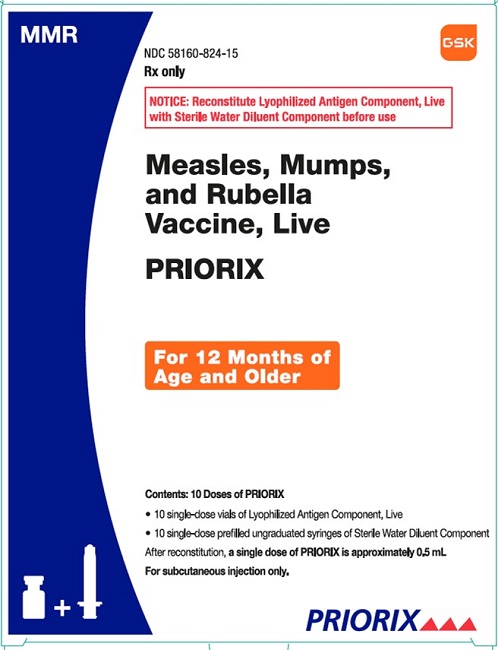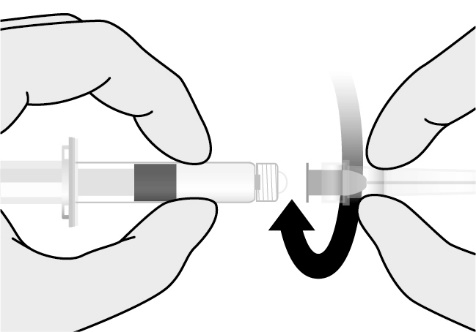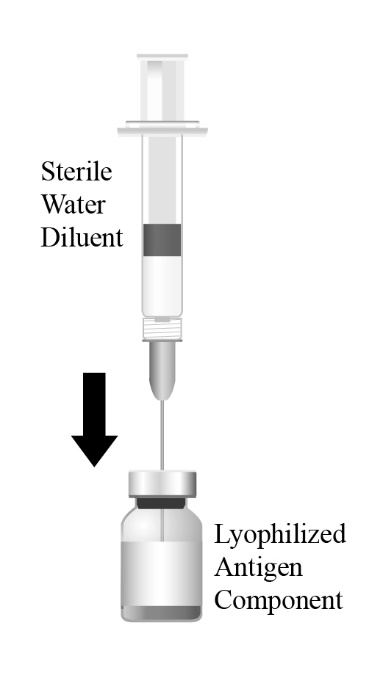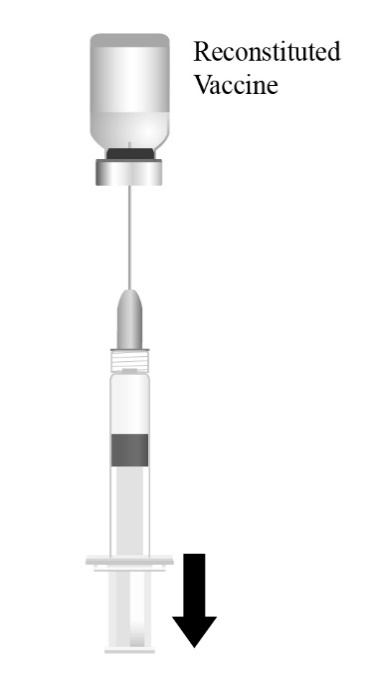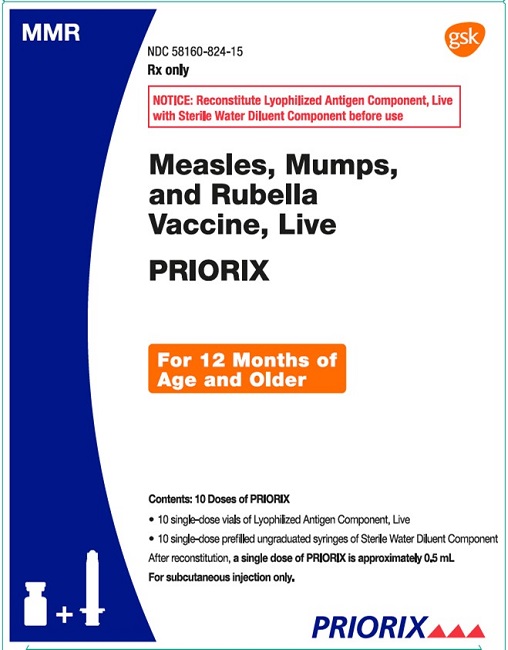The most commonly reported (≥10%) solicited adverse reactions in the following age groups in clinical trials were:
6.1 Clinical Trials Experience
Because clinical trials are conducted under widely varying conditions, adverse reaction rates observed in the clinical trials of a vaccine cannot be directly compared with rates in the clinical trials of another vaccine and may not reflect the rates observed in practice.
The safety of PRIORIX was evaluated in 6 clinical studies, in which a total of 12,151 participants (6,391 in the United States) received at least 1 dose of PRIORIX: 8,780 children (4,148 in the United States) 12 through 15 months of age; 2,917 children (1,950 in the United States) 4 through 6 years of age; and 454 adults and children (293 in the United States) 7 years of age and older. Across the 6 studies, participants who received PRIORIX are as follows: 51.6% were male; 64.6% were White, 18.4% were Asian, 6.1% were Black, and 10.9% were of other racial groups (including American Indian/Native American, Native Hawaiian/Pacific Islander, Arabic/North African and Other); and 14.3% were of Hispanic/Latino ethnicity. The racial/ethnic distribution of participants who received PRIORIX and M‑M‑R II was similar.
Children 12 through 15 Months of Age Who Received PRIORIX as a First Dose
In a randomized, observer-blind, controlled clinical study (Study 1, NCT01702428) conducted in 5 countries (United States [including Puerto Rico], Estonia, Finland, Mexico and Spain), 5,003 participants 12 through 15 months of age received a first dose of PRIORIX (n = 3,714) or M‑M‑R II (n = 1,289) given concomitantly with HAVRIX (Hepatitis A Vaccine) and VARIVAX (Varicella Virus Vaccine Live, Merck & Co., Inc.); children enrolled in the United States also received PREVNAR 13 (Pneumococcal 13-valent Conjugate Vaccine, Pfizer Inc.) concomitantly. In the overall population, 51.3% were male; 75.6% were White, 4.8% were Black, 3.5% were Asian, 16.1% were of other racial groups (including American Indian/Native American, Native Hawaiian/Pacific Islander, Arabic/North African and Other); and 18.6% were of Hispanic/Latino ethnicity. The median age of participants was 12 months (range: 11 to 16 months). Local solicited adverse reactions were recorded by parents or guardians using standardized diary cards for 4 days. Systemic solicited adverse reactions of drowsiness, loss of appetite, and irritability were collected for 15 days, and fever, rash, parotid/salivary gland swelling, febrile convulsions, and signs of meningeal irritation (i.e., neck stiffness with or without photophobia or headache) were collected for 43 days (Table 1). Unsolicited adverse events that occurred within 43 days following vaccination were recorded using diary cards supplemented by medical review. Data on solicited adverse reactions and unsolicited adverse events were transcribed into the study database during an on-site visit on Day 42 and via telephone contact on Day 180.
Total vaccinated cohort for safety included all vaccinated participants for whom safety data were available.
N = Number of participants.
n = Number of participants presenting with solicited adverse reaction described.
a HAVRIX and VARIVAX were administered concomitantly with PRIORIX or M-M-R II; participants in the U.S. also received PREVNAR 13 concomitantly with PRIORIX (n = 1,847) or M-M-R II (n = 654).
b 4 Days, 15 Days, and 43 Days included the day of vaccination and the subsequent 3, 14, and 42 days, respectively.
c Neck stiffness with or without photophobia or headache.
Children 12 through 15 Months of Age Who Received a Second Dose of PRIORIX 6 Weeks after the First Dose
In a randomized, observer-blind, controlled clinical study (Study 2, NCT01681992) conducted in six countries (United States [including Puerto Rico], Czech Republic, Finland, Malaysia, Spain and Thailand), 4,516 participants 12 through 15 months of age received a first dose of PRIORIX (n = 2,990) or M‑M‑R II (n = 1,526) followed by a second dose of the same vaccine 6 weeks later. The first dose was given concomitantly with HAVRIX and VARIVAX; children enrolled in the United States (including Puerto Rico) also received PREVNAR 13 concomitantly. In the overall population, 51.7% were male; 68.4% were White, 24.4% were Asian, 3.2% were Black, and 4.0% were of other racial groups (including American Indian/Native American, Native Hawaiian/Pacific Islander, Arabic/North African and Other); and 5.6% were of Hispanic/Latino ethnicity. The median age of participants was 12 months (range: 11 to 16 months). Local solicited adverse reactions were recorded by parents or guardians using standardized diary cards for 4 days, and systemic adverse reactions of fever, rash, parotid/salivary gland swelling, febrile convulsions, and signs of meningeal irritation (i.e., neck stiffness with or without photophobia or headache) were collected for 43 days. Unsolicited adverse events that occurred within 43 days following vaccination were recorded using diary cards supplemented by medical review. Data on solicited adverse reactions and unsolicited adverse events were transcribed into the study database during on-site visits on Day 42, Day 84, and Day 222. The safety profile of PRIORIX following the second dose was similar to the safety profile following the first dose of PRIORIX.
Children 4 through 6 Years of Age Who Received PRIORIX as a Second Dose of Measles, Mumps, and Rubella Vaccine
In a randomized, observer-blind, controlled clinical study (Study 3, NCT01621802) conducted in 3 countries (United States, South Korea, and Taiwan), 4,007 participants 4 through 6 years of age received PRIORIX (n = 2,917) or M-M-R II (n = 1,090) as a second dose following administration of an initial dose of a combined measles, mumps, and rubella virus-containing vaccine in the second year of life. PRIORIX and M-M-R II were given concomitantly with KINRIX (DTaP-IPV) [Diphtheria and Tetanus Toxoids and Acellular Pertussis Adsorbed and Inactivated Poliovirus Vaccine] and VARIVAX in a subset of subjects (n = 802 receiving PRIORIX, n = 298 receiving M-M-R II) enrolled in the United States. In the overall population, 52.5% were male; 42.4% were White, 37.2% were Asian, 8.2% were Black, and 12.3% were of other racial groups (including American Indian/Native American, Native Hawaiian/Pacific Islander, Arabic/North African and Other) and 17.2% were of Hispanic/Latino ethnicity. The median age of participants was 4 years (range: 3 to 6 years). In a subset of participants who received concomitantly administered vaccines, data on local solicited adverse reactions were recorded by parents or guardians using standardized diary cards for 4 days. Systemic solicited adverse reactions of drowsiness and loss of appetite were collected for 4 days, and fever, rash, parotid/salivary gland swelling, febrile convulsions, and signs of meningeal irritation (i.e., neck stiffness with or without photophobia or headache) were collected for 43 days (Table 2). Unsolicited adverse events that occurred within 43 days following vaccination were recorded using diary cards supplemented by medical review. Data on solicited adverse reactions and unsolicited adverse events were transcribed into the study database during an on‑site visit on Day 42 and via telephone contact on Day 180.
-
- Total vaccinated cohort for safety included all vaccinated participants for whom safety data were available.
N = Number of participants.
-
- n = Number of participants presenting with solicited adverse reaction described.
a 4 Days and 43 Days included the day of vaccination and the subsequent 3 and 42 days, respectively.
b Neck stiffness with or without photophobia or headache.
Individuals 7 Years of Age and Older Who Received PRIORIX as a Second Dose of Measles, Mumps, and Rubella Vaccine
In a randomized, observer-blind, controlled clinical study (Study 4, NCT02058563) conducted in 3 countries (United States, Slovakia, and Estonia), 860 participants 7 years of age and older received PRIORIX (n = 426) or M-M-R II (n = 434) as a second dose following previous administration of a combined measles, mumps, and rubella virus-containing vaccine. Participants 7 through 17 years were enrolled if they had received one dose of a combined measles, mumps, and rubella virus-containing vaccine on or after their first birthday and participants 18 years of age or older were enrolled if they previously received at least one dose of a combined measles, mumps, and rubella virus-containing vaccine. In the overall population, 46.2% were male; 73.8% were White, 0.2% were Asian, 24.0% were Black, and 1.9% were of other racial groups (including American Indian/Native American, Native Hawaiian/Pacific Islander, Arabic/North African and Other) and 13.3% were of Hispanic/Latino ethnicity. The median age of participants was 26 years (range: 7 to 59 years). Data on solicited local and systemic adverse reactions were recorded by the participants or their parents or guardians using standardized diary cards for 4 days and 43 days, respectively (Table 3). Unsolicited adverse events that occurred within 43 days following vaccination were recorded using diary cards supplemented by medical review. Data on solicited adverse reactions and unsolicited adverse events were transcribed into the study database during an on-site visit on Day 42 and via telephone contact on Day 180.
-
- Total vaccinated cohort for safety included all vaccinated participants for whom safety data were available.
N = Number of participants.
-
- n = Number of participants presenting with solicited adverse reaction described.
a Participants received a first dose of either M-M-R II, PRIORIX, or a non-U.S. combined measles, mumps, rubella and varicella virus vaccine.
b 4 Days and 43 Days included the day of vaccination and the subsequent 3 and 42 days, respectively.
c Neck stiffness with or without photophobia or headache.
6.2 Postmarketing Experience
In addition to adverse reactions reported from clinical trials, the following adverse reactions have been identified during postmarketing use of PRIORIX. Because these reactions are reported voluntarily from a population of uncertain size, it is not always possible to reliably estimate their frequency or establish a causal relationship to vaccination with PRIORIX.
Blood and Lymphatic System Disorders
Thrombocytopenia, thrombocytopenic purpura.
Vascular Disorders
Vasculitis (including Henoch-Schönlein purpura and Kawasaki syndrome).
Immune System Disorders
Anaphylactic reactions.
Infections and Infestations
Meningitis, measles-like illness, mumps-like illness (including orchitis, epididymitis, and parotitis).
Musculoskeletal and Connective Tissue Disorders
Arthralgia, arthritis.
Nervous System Disorders
Encephalitis, cerebellitis, cerebellitis-like symptoms (including transient gait disturbance and transient ataxia), Guillain-Barré syndrome, transverse myelitis, peripheral neuritis, afebrile seizures, syncope.
Skin and Subcutaneous Tissue Disorders
Erythema multiforme.

